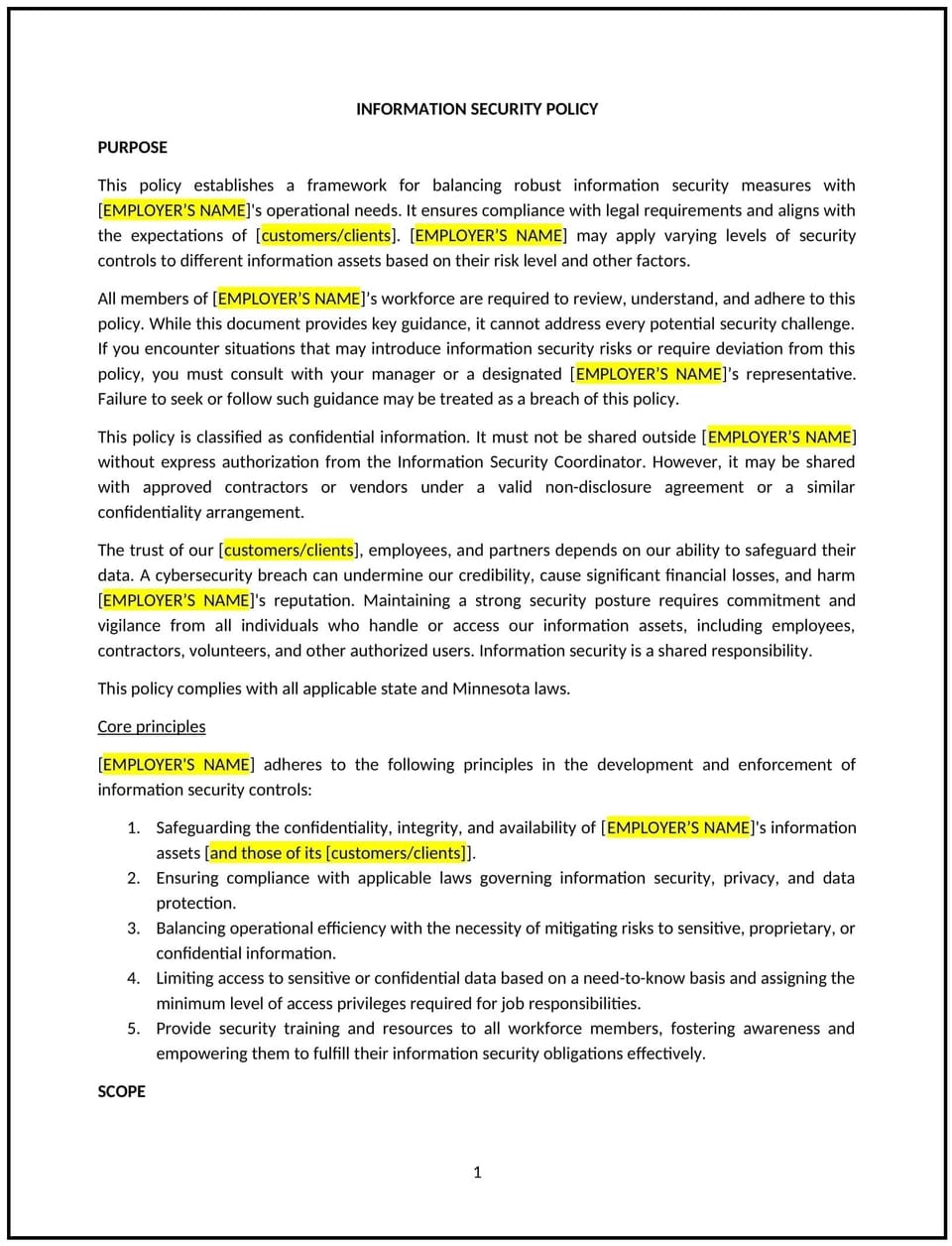Information security policy (Minnesota): Free template

Information security policy (Minnesota)
This information security policy is designed to help Minnesota businesses safeguard their digital and physical information assets. It outlines the company’s approach to preventing unauthorized access, data breaches, and other security risks, while establishing protocols for handling, storing, and transmitting sensitive information. The policy also addresses the roles and responsibilities of employees in protecting information security.
By implementing this policy, businesses can protect client, employee, and company data from potential security threats, reduce the risk of data breaches, and support compliance with applicable laws and industry standards.
How to use this information security policy (Minnesota)
- Define information security roles: Assign responsibility for information security to key personnel within the organization, such as an Information Security Officer (ISO) or IT department, ensuring that there is a designated team overseeing the company’s security efforts.
- Implement access controls: Establish procedures to control who has access to sensitive information, including the use of role-based access controls, password management protocols, and multi-factor authentication (MFA).
- Outline data protection measures: Specify how sensitive data should be protected, including encryption standards, data backup procedures, and secure communication methods.
- Set guidelines for information storage: Define secure practices for storing and handling physical and electronic information, ensuring that sensitive data is not easily accessible to unauthorized individuals.
- Provide employee training: Regularly train employees on information security best practices, including identifying phishing attempts, using strong passwords, and securely handling company data.
- Monitor and audit security practices: Implement continuous monitoring of information security practices, including periodic security audits and vulnerability assessments to identify potential weaknesses.
- Establish an incident response plan: Create a detailed plan for responding to data breaches, security incidents, or other emergencies, including how employees should report incidents and the steps to mitigate damage.
Benefits of using an information security policy (Minnesota)
Implementing this policy provides several advantages for Minnesota businesses:
- Protects sensitive data: By safeguarding company, client, and employee data, businesses can reduce the risk of data breaches, which can result in financial loss and damage to reputation.
- Enhances trust and credibility: Clients, customers, and partners are more likely to trust businesses that prioritize information security and demonstrate a commitment to protecting sensitive data.
- Reduces legal and financial risk: Businesses that protect sensitive data are less likely to face fines, lawsuits, or reputational damage from data breaches, particularly under data protection regulations.
- Increases employee awareness: Regular training and awareness initiatives help employees understand the importance of data security and how they can contribute to protecting the company’s information assets.
- Reflects Minnesota-specific considerations: Tailors the policy to meet Minnesota’s specific data protection regulations and business needs, taking into account the local regulatory landscape and industry best practices.
Tips for using this information security policy (Minnesota)
- Communicate clearly: Ensure that all employees understand the importance of information security, their roles in protecting data, and the procedures for reporting security incidents.
- Train regularly: Conduct ongoing security training to keep employees up-to-date on new security threats, best practices, and the tools available to help secure company data.
- Review access controls: Regularly audit access permissions to ensure that only authorized employees have access to sensitive information and systems.
- Implement strong encryption: Require encryption for sensitive data, both at rest and in transit, to protect it from unauthorized access.
- Monitor for threats: Use security tools and software to monitor for potential threats, such as malware, phishing attacks, and unauthorized access attempts.
- Review and update the policy: Periodically review and update the policy to address emerging security threats, regulatory changes, and advancements in technology.
Q: Who is responsible for information security within the company?
A: Businesses should designate specific roles, such as an Information Security Officer (ISO) or IT manager, to oversee information security. All employees, however, have a responsibility to follow the company’s information security protocols and report any concerns.
Q: How should sensitive data be protected?
A: Sensitive data should be protected using encryption, secure storage methods, and access controls. Businesses should also implement secure communication protocols (e.g., VPNs) and ensure that data is only shared with authorized individuals.
Q: What steps should employees take to secure their work devices?
A: Employees should use strong passwords, enable multi-factor authentication, lock devices when not in use, and report any lost or stolen devices immediately. They should also avoid using unsecured networks to access company data.
Q: What should employees do if they notice a security incident or breach?
A: Employees should immediately report any suspected security incidents, such as a phishing email or unauthorized access to company data, to the IT department or security officer. Businesses should have clear procedures in place for responding to security breaches.
Q: How does the company ensure access is limited to authorized individuals?
A: Businesses should implement role-based access controls, ensure that only necessary employees have access to sensitive information, and regularly audit permissions to ensure that access remains appropriate.
Q: How can businesses protect against phishing attacks?
A: Employees should be trained to recognize phishing emails, avoid clicking on suspicious links, and verify the authenticity of requests before sharing sensitive information. Regular phishing simulations and security awareness campaigns can help prevent these attacks.
Q: How often should the information security policy be reviewed?
A: The policy should be reviewed at least annually or whenever there are significant changes to the company’s technology, regulatory environment, or security needs.
Q: Can the company provide remote workers with secure access to company systems?
A: Yes, businesses should implement secure remote work solutions, such as Virtual Private Networks (VPNs), secure file-sharing platforms, and encryption, to ensure that remote workers can access company systems securely.
This article contains general legal information and does not contain legal advice. Cobrief is not a law firm or a substitute for an attorney or law firm. The law is complex and changes often. For legal advice, please ask a lawyer.


